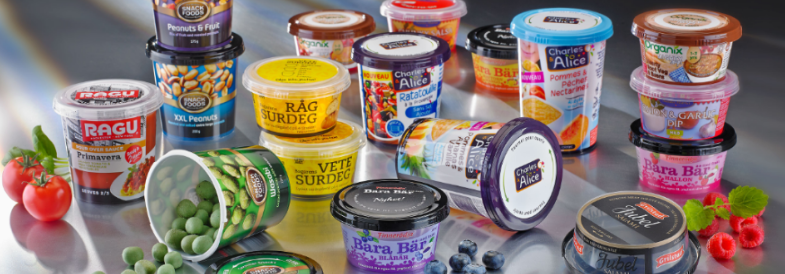
From the invention of plastic in the late 19th century to the introduction of Tupperware® in the 1940s to the latest innovations in easy-to-soak ketchup packaging, plastic has played an indispensable role in smart packaging solutions, helping us reduce more cost. Whether it's your new electronics, your favorite beauty product, or what you eat for lunch, plastic packaging helps protect your purchases until you are ready to use them, which helps reduce waste and save energy.
Plastic packaging innovation in 1862
Alexander Parkes unveiled the first man-made plastic at Alexander Parkes' international exhibition in London. The material called Paxaine comes from cellulose. Yes-the first plastic is bio-based! It can be shaped when heated and retains its shape when cooled.
Plastic packaging innovation in the early twentieth century
Swiss textile engineer Dr. Jacques Edwin Brandenberger created cellophane, a transparent layer packaging for any product-the first fully flexible waterproof packaging. Brandenberger's original goal was to apply a clear and soft film to the cloth to make it stain resistant.
1930 Plastic Packaging Innovation
3M engineer Richard Drew invented Scotch® cellulose tape. It was later renamed cellophane tape, which is an attractive way for grocers and bakers to seal the package.
Plastic packaging innovation in 1933
Ralph Wiley, a worker at the Dow Chemical Laboratory, accidentally discovered another plastic: polyvinylidene chloride, called SaranTM. The plastic was first used to protect military equipment and then to food packaging. Saran can keep almost any material-bowls, dishes, jars, and even itself-and becomes an excellent tool for maintaining fresh food at home.
Plastic packaging innovation in 1946
Tupperware® was developed by Earl Silas Tupper of the United States, who ingeniously promoted his polyethylene food container series through a network of housewives selling Tupperware as a means of making money. Tupperware and other plastic containers with airtight seals are one of the most significant products in the history of plastic packaging.
Plastic packaging innovation in 1946
The first major commercial plastic spray bottle was developed by Dr. Jules Montenier, the founder of "Stopette". Buttocks deodorant was dispensed by squeezing his plastic bottle. As a sponsor of the popular "What's My Line" TV show, Stopette sparked an explosion in the use of plastic bottles.
Plastic packaging innovation in 1950
The familiar black or green plastic garbage bag (made of polyethylene) was invented by Canadians Harry Wasylyk and Larry Hansen. The new garbage bags currently used for commercial purposes are first sold to Winnipeg General Hospital. They later became popular for family use.
Plastic packaging innovation in 1954
Robert Vergobbi patented zipper storage bag. Minigrip authorized them and intends to use it as a pencil bag. But it is obvious that bags can be made more, Ziploc® bags were introduced as food storage bags in 1968. The first bag and sandwich bag on the roll are introduced
Plastic packaging innovation in 1959
Wisconsin manufacturers Geuder, Paeschke, and Frey produced the first authorized character lunch box: a lithograph of Mickey Mouse on an oval tin with a pull-out tray inside. Plastic was used for the handle and then for the entire box, starting in the 1960s.
Plastic packaging innovation in 1960
Engineers Alfred Fielding and Marc Chavannes created BubbleWrap® in their company called Sealed Air Corporation.
Plastic packaging innovation in 1986
In the mid-1950s, Swanson® TV dinners took advantage of two post-war trends: the popularity of time-saving devices and the obsession with TV (in the first year of national distribution, more than 10 million TV dinners were sold). In 1986, aluminum trays were replaced by plastic and microwave trays.
Plastic packaging innovation in 1988
The Plastics Industry Association introduced a voluntary resin identification coding system, which provides a consistent system for identifying plastic resins used in packaging containers.
Plastic packaging innovation in 1996
The introduction of a salad pack (metallocene-catalyzed polyolefin) helps reduce food waste and makes it easier to buy fresh produce.
2000 Plastic Packaging Innovation
Soft yogurt tubes are available, so you can enjoy delicious calcium-rich snacks anytime, anywhere.
2000 Plastic Packaging Innovation
Introduce polylactic acid (PLA) made from corn to the packaging market and recycle bio-based plastics into packaging.
2007 Plastic Packaging Innovation
Two-liter plastic beverage bottles and one-gallon plastic milk jugs have reached milestones in "lightweight"-since they were widely used in the 1970s, the weight of both containers has been reduced by a third.
Plastic packaging innovation in 2008
Plastic bottles reached a 27% recycling rate, and 2.4 billion pounds of plastic were recycled. (Since 1990, more plastic bottles per pound have been recycled!) The recycling rate of polyethylene plastic bags and packaging has reached 13%, and 832 million pounds of plastic have been recycled. (Since 2005, the recycling rate of polyethylene plastic bags and packaging has doubled.)
2010 Plastic Packaging Innovation
The Metallyte TM film is introduced to help keep the content refreshed (coffee beans, grains, noodles, bread slices) by reducing tears in the packaging. The new film is also lighter than the foil-based design.
2010 Plastic Packaging Innovation
TM is the first tomato sauce packaging innovation in 42 years. It is a dual-function package that provides two ways to enjoy tomato sauce: peel off the lid for easy soaking, or tear off the tip to squeeze the food. The new packaging makes eating more interesting and convenient.
Post time: May-27-2021






